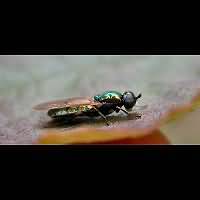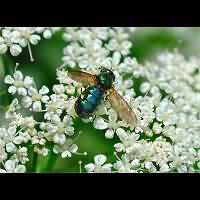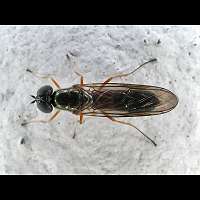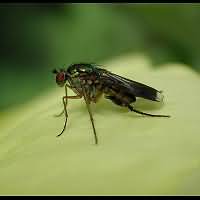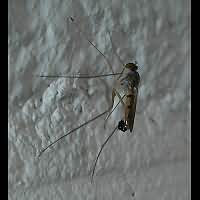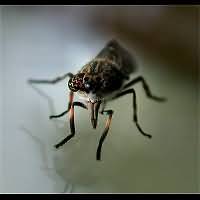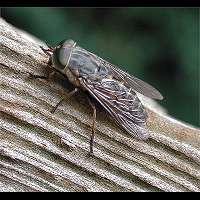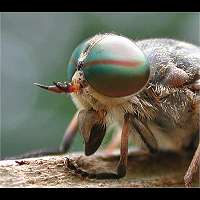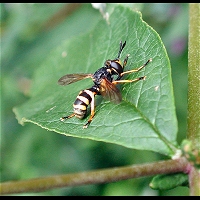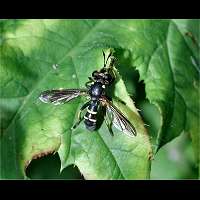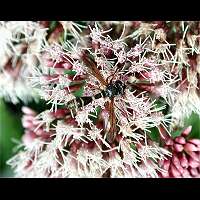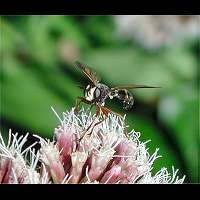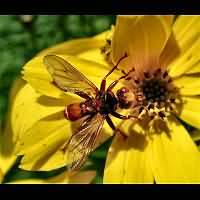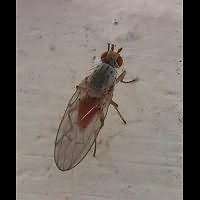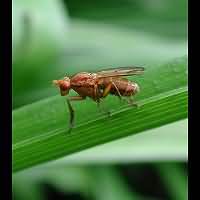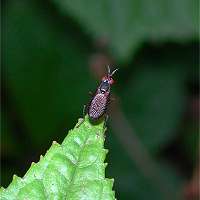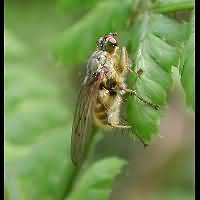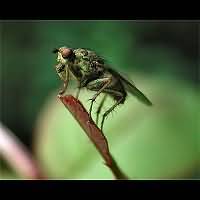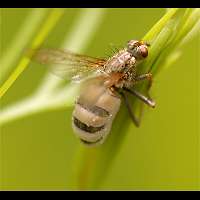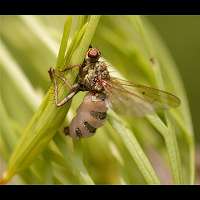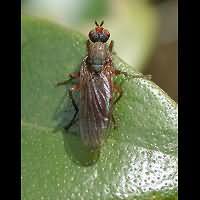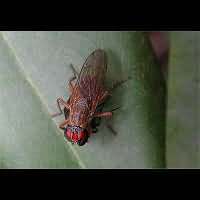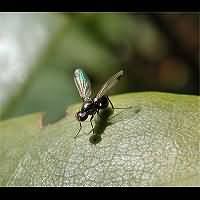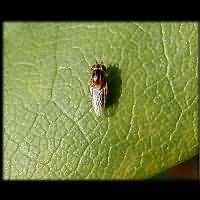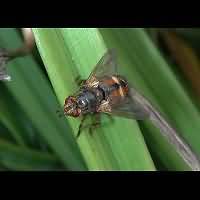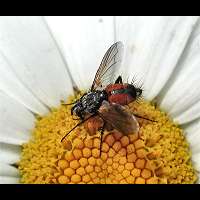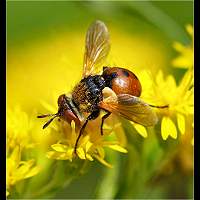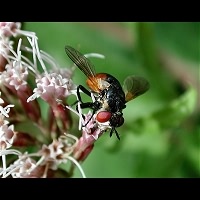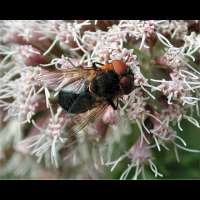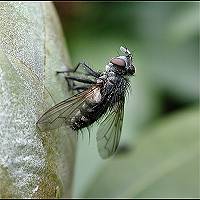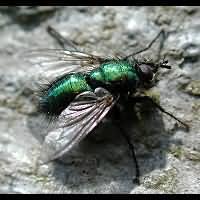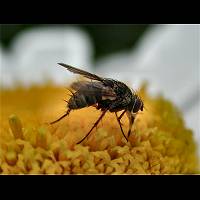[All pictures of garden wildlife on this page are thumbnails. Click on any thumbnail for a large format to be displayed.]
It is very difficult to tell flies apart from mosquitoes, but usually they are more robust, have short antennae and bigger legs and eyes. Scientifically it is still discussed whether there is a real difference between these two groups. But usually everyone 'feels' the difference.
Content: 1 Soldier Flies, 2 Long-legged Flies, 3 Bee Flies, 4 Horse Flies, 5 Snipe Flies, 6 Thick-headed Flies, 7 Sunflies, 8 Snail-killing Flies, 9 Dung Flies, 10 Grass Flies 11 Parasitic Flies, 12 Woodlouse Parasite Flies.
1 Soldier Flies (Stratiomydae)
Soldier Flies are rather primitive, flat flies, most of the time beautifully coloured. They are not very apt flyers. Even though some species do eat nectar or pollen from flowers, one commonly sees them bathing in the sun on a leaf. The larvae have no legs, are shaped conically and live in water or very moist earth. When you see them resting you often don't note the beautiful colours, for they fold the wings over the colourful abdomen. In the garden the Green Soldier Fly below is very common. It regularly visits flowers to eat some pollen or nectar. The species is also known as the Broad Centurion or the Broad Centurion Soldier Fly.
The Green Soldier Fly (Chloromyia formosa) is among the most common Soldier Flies in gardens.
The genus Sargus consists of a number of similar, green metallic Soldier Flies. There are a number of species in Europe. The Twin-spot Centurion Soldier Fly below may be identified easily, for it has two, clear white spots on its face. Males have an orange brown spot on the first part of the abdomen, while females have their entire abdomen in a greenish brown colouration. This is a fairly big species, capable of reaching a length of some 16 mm. Should you care to look for the larvae, you should be digging in manure.
This is the Two-spotted Centurion Soldier Fly (Sargus bipunctatus). The picture to the right tells you why it is named that way.
2 Long-legged Flies (Dolichopodidae)
There are various groups of long-legged flies. The fly to the left belongs to a group of smaller flies. Their lifestyle is identical to that of the robber flies, even though their prey is much smaller. Some species are even used in biological farming. The tail is always curled and they have a very beautiful green metallic colour on top. They will neither bite nor sting people. The fly to the right belongs to the same family of long-legged flies, but it lacks the green metallic colouring found in most members of his family. What both species do have in common is the curled tail. These actually are the reproductive organs. These are big and curled in this fly family.
Left: a beautiful Long-legged Fly (Poecilobothrus nobilitatus). To the right: the gracious Neurigona quadrifasciata.
Numerous flies don't want to look like a fly at all. The beeflies for instance pretend to be bees. Enemies often leave bees alone, for they can sting. By mimicing a bee as well the bee fly hopes for the same respect predators have for real bees. This is a small family of very hairy, rather big flies, that are excellent flyers. In our garden the Greater Bee Fly appears in late spring.
The Greater Bee Fly (Bombylius major) looks like a bumble bee, but she's not ![]()
Even though most flies are just 'filthy' animals, a few can be a nuisance indeed. The horse flies especially are dreaded, because they are able to bite people painfully. The females of these flies, also called gadflies or clegs, need blood in order to develop eggs, just like mosquitoes do. Mosquitoes have developed an injection needle to sting. The sting by itself is painless. However they inject certain fluids that can cause itchy bumps. These fluids prevent the blood from coagulating. Horse flies lack the injection needle. They have razor like jaws instead that cut into your flesh untill the bloods starts to run. This blood is then sucked up with a tongue that looks very much like the house fly's. You can really feel the bite. Most of these flies concentrate on bigger mammals, such as horses and cows, but the Common Horse Fly (or Cleg-fly) is fond of humans as well, especially when a thunderstorm approaches. When resting Horse Flies fold their wings over their body. When actively walking about however, they spread their wings. The female below to the left apparently found food on our car and sucked it up running about. You can see clearly now that the body has some bands at the end of each segment. Also the beautiful pattern on the wings becomes very striking. But Cleggs are best known for their wonderful eyes. Each species has another pattern of lines and colours, so you can even tell apart the various species by just looking them in the face! There are a few species though that just have brown eyes, without any lines or colours, so be careful when deciding the fly you're studying is not a Horse Fly. Below to the right a male. It has got much bigger eyes, but the entire upper part is plain brown. Only the lowest parts reveals two colourful lines.
The Common Horse Fly or Cleg-fly has an interesting Latin name: Haematopota pluvialis = blooddrinker of the rains.
The genus Tabanus consists of a number of well known species. Usually they are called clegs, horse-flies or gad-flies, without referring to one specific species. Most of them prefer cows and horses over humans, but they will bite given the chance. Often seen in meadows and around stables, but especially the Band-eyed Brown Horsefly, below, also frequents river banks and is dreaded by anglers. The larvae are hunters in shallow waters. The adults have clear wings and only one band in the eyes. This can however only been seen by looking from below or up front. It is a very common species all over Europe, even in mountainous areas up to 2,000 metres.
The Band-eyed Brown Horsefly (Tabanus bromius) has very striking eyes as well.
The Snipe Fly family falls apart in two groups. First of all there are the Down-looker Flies. These are all looking down when resting and they appear mainly in forests and woodlands. Their larvae feed on insects and other small animals that live between the leaves on the forest floor. The Down-Looker Flies are the family's biggest representatives and have peculiar spots on the wings. The one to the left has been identified with the help of Hans Hillewaert. Another group of flies within the family of Snipe Flies are the Snout Flies. They do not necessarily rest with their head down. The fly to the right has been identified by Ruud. Thank you both very much.
Left: the most common Downlooker Snipefly: Rhagio scolopacea. Right: a female Chrysopilus auratus, a Snout Fly.
6 Thick-headed Flies (Conopidae)
This family of flies has the name it deserves, but a part of it is also referred to as Wasp Flies. They look like hover flies and the adults can be found on the same flowers as the hover flies. However their larvae are parasites to wasps, bees and bumble bees. The adults are shaped and coloured more like wasps than the hover flies are. There are many species looking just like another. Many Thick-headed Flies can be recognized by looking at the very long antennae, quite unusual in flies. The female appears to be darker, for she has only two yellow markings on the body, where the male has three. And usually hers are much smaller.
Conops flavipes is a good wasp mimic and even has long, wasp like antennae, hardly ever found in flies. To the left a male, to the right a female.
Taking it even a step further: the Thick-headed Flies belonging to the Physocephala genus. Not only are they black and yellow and have unusually long antennae, just like the Conops above, but they even have the typical wasp's waist, rarely encountered in flies. Reaching some 9 tot 13 mm it is about the same size as many of the wasps it imitates. Physocephala rufipes is not only a parasite to the Common Carder Bee, but to the Garden Bumblebee, the Earth Bumblebee and the Red-tailed Bumblebee as well. This species is on the wing the same a time most of the Thick-headed Flies are: from mid-May to mid-August.
This Physocephala rufipes is among the best wasp imitators.
Other Thick-headed Flies don't look like wasps at all, but might also visit your flowergarden in summer, such as Sicus ferrugineus. All Thick-headed Flies attack their victim in flight. They have a long, thin ovipositor which they inject into the abdomen of their victim to lay an egg. Usually one egg is laid, but some species inject up to nine eggs into their prey. Strangely enough it is normally the worker bee or wasp that is choosen. Males are not often infected and queens are even rarely attacked. The species below is especially interested in Bumble Bees.
This is a Thick-headed Fly not looking like a wasp at all: Sicus ferrugineus.
Ruud van der Weele, who helped me a lot in identifying various flies, is a specialist on this family himself. The Sunflies are not very well known to the general public, but they are interesting enough. According to Ruud, this family bloomed during the Ice Age. When the earth warmed up again, many mambers of this family stay behind, high in the mountains, in the Arctic, in caves and in dark forests. The species below is very common in the Benelux area and can be seen in gardens and around farms regularly. The larvae live off decaying materials and can be found in dung heaps etc.
This is a Sun Fly (Tephrochlamys rufiventris).
8 Snail Killing Flies (Sciomyzidae)
This is a family of small to medium sized flies. The members of this family deposit their eggs near snails. The larvae eat the snail. This means that the members of this family are useful in biological pest control. They are bred to reduce the number of snails in farming. But they are also the living proof of how complicated matters like these can become. The flies don't distinguish between noxious snails and slugs and useful ones. How could they? So what is a blessing for one branch of agriculture is a pest for the other, namely the farmers that breed edible snails. The species below to the left looks like a Dung Fly and is often mistaken for one. The species below to the right is also commercially used for killing snails. The females do not look for snails to lay the eggs on, they simply drop them on the ground. When the weather is favorable, which mains quite wet, the larvae will hunt down the snails themselves.
The larvae of these flies, to the left most probably Tetanocera elata and to the right Coremacera marginata, eat snails and slugs.
9 Dung Flies (Scathophagidae, Sepsidae)
Another family of filthy flies: the Dung Flies. Some species deposit their eggs in cow dung. The eggs have little 'wings' on both sides to prevent them for sinking into the fresh cow-manure. Luckily it does not enter your house by habit and is mainly seen on flowers in the garden sucking nectar. There are various species of Dung Flies; the Yellow one is known best. Most adult dung flies are carnivorous and hunt for other insects. By the way: many species don't lay their eggs in dung. The larvae of the smaller species live inside leaves of plants, while the larvae of others live on other larvae and insects.
To the left the golden male and to the right the more greenish female of the Yellow Dung Fly (Scathophaga stercoraria).
We all know that all this running around on dung can't be healthy. Well, most flies don't seem to bother about it, but even flies can get a disease. Especially the Yellow Dung Fly is vulnerable. The animals sometimes suffer from a disease caused by a fungus called Entomophaga. The fungus grows between the segments of the body. If the animal is almost entirely digested by the fungus it somehow sees to it that the fly climbs on top of some plant. There the fly dies and the circumstances are ideal for the fungus to release its spores. Parasites do regularly cause a change in an animal's usual behavior. Stylopized bees often behave in a strange way. Plant lice infected by parasitic wasps often climb on top of a leaf in stead of hiding beneath it.
Yellow Dung Fly (Scathophaga stercoraria) infected by the fungus Entomophaga.
Adult Dung Flies will eat anything. They are often found on flowers, sucking nectar or hunting for other insects. They suck them dry by means of a short but powerful snout, like to the right below.
Unidentified Dung-fly, to the right holding a freshly caught prey.
The flies we call Dung Flies actually belong to more than just one family. The Sepsidae are dung flies as well and are better known as Lesser Dung Flies. They too deposit their eggs in dung and even the adults eat rotting organic materials. Most members of this family are small, shining black flies with a very rounded head and a body shaped like an ant's. This way they do remind one of Mickey Mouse. It is very difficult to tell the various species apart. The way the species below hold its wings is typical of this family: half open and half upright. Below probably the most common representative of these flies in the Benelux: Sepsis fulgens, identified by Pascal. Thank you very much indeed.
This small black Lesser Dung Fly (Sepsis fulgens) looks like Mickey Mouse.
This family of small to extremely small flies is also known as Swarming Flies, Eye Gnats and Frit Flies. There are many almost identical species within this group, most of them black and yellow. Between the true eyes the ocelli (secondary eyes) take up a lot of space. Most species are hairless. They often go about unnoticed, because of their size. The real big species may reach one centimeter, but most species, like the one in the pictures below, reach some 3 or 4 millimeters only. The only time ordinary people notice them is when they appear in a swarm, often comprised of tens of thousands of animals. The larvae live in the stems of grasses, including cultivated grasses and grains. Some species are treated as pests. The animal below was photographed in early spring and is believed to be a Chlorops species, but we are not sure at all.
Small and black and yellow: typically a Grass Fly (Chlorops sp.?)
11 Parasitic Flies (Tachinidae)
Parasitic flies sometimes look like houseflies very much, but they belong to another group of flies all together. There are many species of parasitic flies, most are very small and lay their eggs in other very small animals, such as plant lice. The species below does look like the Common Housefly, but it has more and longer hairs. Parasitic flies lay their eggs near or in the larvae of other insects. After hatching the larva of the fly starts to eat the larva of the other insect. There are many species, in the Benelux alone well over 300, and each species is specialized on certain insects. Identifying parasitic flies is a hell of a job. Luckily we have an expert helping us: Hans-Peter Tschorsnig. To the left is one of the most common parasitic flies in the Benelux. It deposits its eggs near the caterpillars of butterflies and moths. The larvae almost immediately hatch and eat the caterpillar.
To the left: the very common Tachina fera. To the right: Eriothrix rufomaculatus.
Most parasitic flies have firm and long hairs all over their body, but not all. The one to the right is almost hairless. It belongs to a group of parasitic flies that are almost hairless. its larva eats bugs. In my part of the Netherlands this is the only Gymnosoma species present. In the south of Limburg however e second species may turn up, which is very similar to this one indeed.
This is the almost hairless Gymnosoma nudifrons, a parasite of bugs. To the left the male, to the right the female.
The parasitic fly below was first seen in our garden in July 2002. It's a real eye-catcher among flies: the wings are really beautiful. For parasitic flies especially this is remarkable, for most have a pair of plain wings. The depicted specimen is a male: the female has plain and much smaller wings. This parasitic fly deposits the eggs in shield bugs.
This beautiful parasitic fly (Phasia hemiptera) deposits its eggs into shield bugs. To the left a male and to the right a female.
At last in the summer of 2004 ir appeared in our garden for the first time: Tachina grossa, the biggest fly in Western Europa, depicted below to the left. Not difficult to identify by the big, black body and the orange face. It is very hairy indeed and looks very much like a bumble bee. Reaching a length of up to 21 mm it is even bigger than any of our bumble bees. It does remind one of the very common Mid-day Fly, only its face is entirely orange, it is hairy and, of course, it is much bigger. A large species like this is in need of big hosts of course. The eggs are usually deposited in the fat caterpillars of the Eggar Moths, which is a family of impressive, owlet like moths. Once seen, you'll never forget this species. Below to the right the extremely common Phorocera obscura. Few people ever realised they saw it though. It doesn't look like your typical parasitic fly: in stead of a robust, rounded body it has a rather slender body. And the markings are very similar to those of the Common Flesh Fly. No doubt many people do think that's what they observe, when actually seeing this parasitic fly. The larvae live on caterpillars of moths, Geometers mainly, even though sometimes they are found on Noctuids. The fly concentrates on species flying about in autumn, winter or spring, such as the Pale Brindled Beauty, the Scarce Umber Moth, the Spring Usher and the Winter Moth. The adult flies are seen from April to mid-June. This species only has one generation a year.
To the left: Tachina grossa, the biggest fly in Western Europe, reaching a length of some 21 mm. To the right: Phorocera obscura is often mistaken for a Flesh Fly.
The Green Parasitic Fly to the left looks very much like the well known Greenbottle. You can however distinguish the two species when you have a chance to study them closely: the Greenbottle has almost no hairs, while the Green Parasitic Fly has long and stiff hairs. its larvae eat the caterpillars of various moths species. The larvae of the Greenbottle are scavengers. There are more species that look like the Greenbottle. One of them lays its eggs in the nose of toads! The genus Siphona is comprised of a number of small, grey and very similar species. It is very hard indeed to name them from just a photograph. The species in the pictures below to the right is extremely useful in one's garden, because it prefers the larvae of Crane Flies, a major pest in lawns. One Crane Fly larva may contain dozens of Siphona geniculata larvae!
To the left: the Green Parasitic Fly (Gymnocheta viridis). To the right: not a big species, but a very useful one for lawn owners: Siphona geniculata.
12 Woodlouse Parasite Flies (Rhinophoridae)
The Woodlouse Parasite Flies behave more or less like the Parasitic Flies, but they differ in the way they look and the venation in the wings differs. It is a small family, represented by some 6 species in Britain. The larvae are parasites to woodlouse, but live inside snails or beetles as well. Except for differences in appearance there is also a big difference in behavior. Parasitic Flies lay there eggs on or even in the host. The Woodlouse Parasite Flies just lay their eggs in the vicinity of woodlouse colonies. After hatching, the larva has to find a host all by itself. The species below is very common in gardens and the larvae especially attack the Common Rough Woodlouse. Usually the species is double brooded. The larvae eat their host from the inside, untill just the external skeleton of the victim remains. In it the larva overwinters.
This Rhinophora lepida is especially interested in the Common Rough Woodlouse.

© Copyright 1998-2024 gardensafari.net (Hania Berdys)

 English / engels
English / engels  Dutch / nederlands
Dutch / nederlands